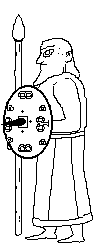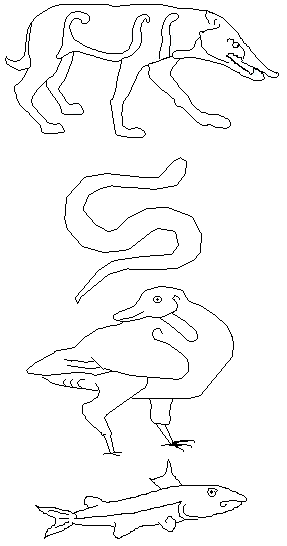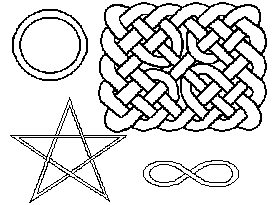  II - ROMAN INVASIONS ... THE HISTORY OF SCOTLAND BEGINS
II - ROMAN INVASIONS ... THE HISTORY OF SCOTLAND BEGINSFrom their invasion of the British Isles in 43 AD until the appointment of Cnæus Julius Agricola as governor in 78 AD, much of the effort of the Roman commanders was directed at bringing the greater part of the middle and southern England under control. Agricola subdued the country south of the Forth and Clyde Firths and prepared to move into Caledonia [Northern Pictland] when he heard that its people had formed a confederacy to resist the invader. The battle of Mons Graupius, fought in north-east Pictland in 84 AD, was recorded by the Roman historian Tacitus, the son-in-law of Agricola. Since the writings of Tacitus provide more than a mere list of kings or description of archaeological items, some would say that the history of Scotland begins with this battle. Tacitus noted that this Iron Age army of tall, reddish-haired men with great limbs fought using a metre-long sword and a small round buckler shield in battle. They were the first army in recorded history to use these weapons. [Forerunners of the Scottish dirk and targe (shield) were developed during the Bronze Age.] 
  [Reports and descriptions of the allegedly tatooed Picti in Southern England could have reached the emperor Claudius (10 BC - 54 AD), but these people were not the Caledonian Picts who met the Roman army thirty years after his death.]
[Reports and descriptions of the allegedly tatooed Picti in Southern England could have reached the emperor Claudius (10 BC - 54 AD), but these people were not the Caledonian Picts who met the Roman army thirty years after his death.] The Alexandrian Greek mathematician and geographer Claudius Ptolemy, writing in the 2nd century AD, produced a map of the British Isles which gave names to the tribes settled in various regions; between the Beauly Firth and the Strath of Kildonan he placed a people which he called the Decantae. The great Bede, writing in 731 A.D., recorded four groups of people living in Britain: the Britons, Picts, Scots, and Angles.  The Celtic Gaelic tribe of Scots began to settle a Kingdom of Dalriada in western Pictland during the early 5th century. By 409 AD the Romans, unable to conquer the Caledonian Picts, left the Britons to defend themselves against the Picts and Scots, who often fought as allies. Around 450 AD, the monk Gildas referred to them as "foul hordes of Scots and Picts, like dark throngs of worms who wriggle out of narrow fissures in the roack when the sun is high and the weather grows warm". By way of contrast, there is evidence of a thriving Pictish civilization and culture. "Symbol Stones" and Pictish art fluourished between the late 5th and the 9th centuries. Predating Christianity, a continuous geometric symbol, sometimes involving complex interlacing, represented eternity. _______________ REFERENCES: Once again, Part I of John Prebble's Lion In The North (Secker and Warburgh, London, 1971) is a good place to start. Some further internet websites of 1996 and 1997 have proven useful for this part of the story. One excellent source for early history is Electric Scotland Ltd. at Grangemouth, Scotland. Heather Rose Jones provides a most interesting study of Pictish Names ©1996. Robert M. Gunn tells about "The Romans in Scotland" in his Scottish Origins ... up to William Wallace ©1997. Aside from confusing the Picts of southern Roman Britain with the Caledonian Picts (as noted in my story), the series by F. Lennox Campello is generally informative. Due to the nature of the internet, sources can disappear for a variety of reasons, and new ones may be discovered by using key words when you are doing a search. |





